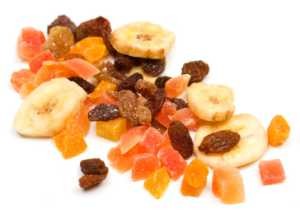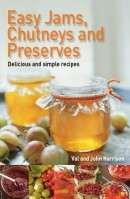Drying fruits is generally easy. Most fruits can be dried and are very palatable, in some cases delicious, in their dried form. Dried fruits have always been a popular line in the health food shops and there is no reason why you can’t make your own.

Drying Fruits is Easy and the Results are Delicious
Drying Fruits
Drying Plums, Apricots, Nectarines and Peaches
Plums and apricots can be dried whole but, if they are on the large size, they are better halved and stoned. Peaches and nectarines need to be halved and stoned.
- Wash the fruit, pat dry with kitchen roll and place the fruit in a single layer on the drying tray.
- If they are halved, they should be placed with the cut side upwards so that the juice does not run out.
- Start the drying process at 50°C/120°F/Gas Mark 0. The skins will burst and some of the juice will be lost if they are dried at a higher temperature.
- Once the skins begin to shrivel, the temperature can be raised to 65°C/150°F/Gas Mark 0 to complete the drying process.
- When finished, remove the trays from the heat source and leave to cool at room temperature for 12 hours. Pack the fruit in wooden or cardboard boxes lined with greaseproof paper or, better, airtight jars or containers and store in a very dry place.
Drying Apples and Pears
- Peel and core the Apples or Pears.
- Apples should be cut into ¼” (5mm) rings and pears into halves or quarters depending on their size.
- Place the pieces into a bowl of cold salted water immediately for a few minutes to prevent discoloration. Use about 2 oz (56 g) of salt to each 1 gallon (4.5 litres) of water.
- Lift out with a perforated spoon and pat fully dry with kitchen paper roll.
- Place the pieces of fruit in single layers on the drying tray and cover with a piece of muslin to keep the fruit clean whilst it is drying.
- Check that they are fully dry by pressing 2 or 3 pieces together and, if they feel rubbery and spring back into shape, they are ready.
- Remove from the heat source and leave for about 12 hours. If flies are about, cover with muslin or cheesecloth.
- Pack into wooden or cardboard boxes lined with greaseproof paper or, better, airtight jars or containers and store in a very dry place.
Grapes to Raisins
Raisins are simply dried grapes. In the Mediterranean they simply take the bunches of seedless grapes and lay them in the sun for a couple of weeks before removing from the stems and spreading on trays to dry further. They really need a long period of relatively gentle warmth, say 30°C (86°F) so not so easy in colder and less sunny northern climes where grapes are better turned into wine.
Berries
Most berries can be dried. With larger berries, like strawberries, they’re best sliced before drying. Berries can take a surprisingly long time to dry and we find that generally they’re best stored in other ways.
Fruit Leather
Most fruits can be made into fruit leather. The method is quite simple. First make a thick puree from the fruit. Avoid adding any water if you can, the puree wants to be as dry as you can get it.
Spread thinly, 5mm or ¼ inch thick onto a tray and dry in your preferred method, oven or dryer. The leather is best stored in airtight containers in the refrigerator and can be used cut up into chips in cakes, ice cream or desserts.
More on Drying & Dehydration
- Drying Apples & Pears – How to Dry Apples & Pears
- Drying Apricots, Peaches, Plums – How to Dry Apricots etc.
- Drying Fruits – How to Dry and Store Fruits, Fruit Leather
- Drying Runner & French Beans – How to Dry Runner & French Beans
- Drying Herbs – How to Dry and Store Herbs
- Drying Vegetables – How to Dry and Store Vegetables
- Sun Dried Tomatoes – How to Dry Tomatoes
- Drying Beans & Peas – How to Dry Beans & Peas at Home
- Drying Onions – How to Dry Onions


